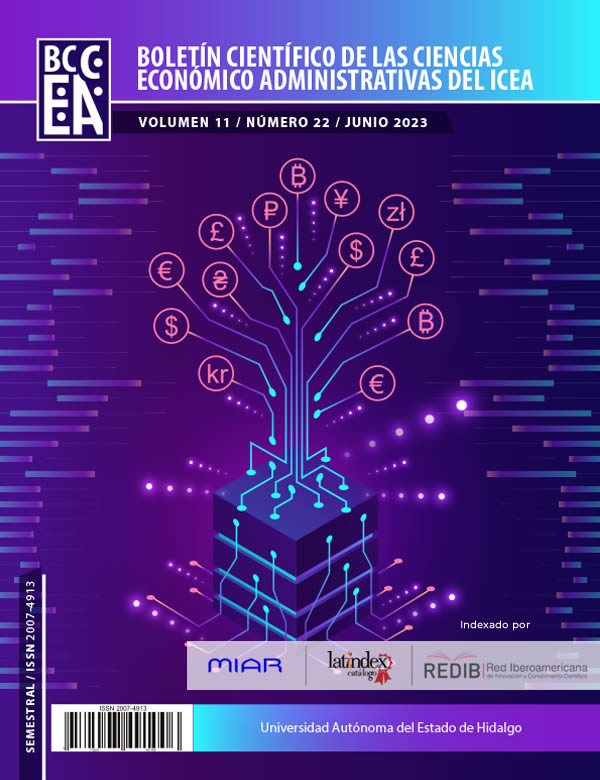Forest bathing dynamic element for sustainable development in tourism
Abstract
The Covid-19 pandemic had an economic and psychosocial impact on the world, in the case of tourism it was one of the most affected sectors. The pandemic made us more aware of valuing health and environment, the challenge is to identify how to reach the 2030 agenda, which impact directly with people's health, decent jobs and improving the economy in general, To provide an alternative to this problems, the objective of this work is to identify forest bathing as a viable alternative to be used as a facilitating element for sustainable development and for some of the 2030 agenda objectives. Through an exploratory type research supported by documentary analysis, it was possible to identify forest baths as a powerful alternative to serve as a catalyst for sustainable development and mainly in some of the objectives of sustainable development. The main conclusions point to the fact that forest baths are a very useful tool that can have a very positive impact on modern life and help preserve the environment, health and boost tourism.
Downloads
References
Aldrete Rodríguez, M. G., y Cruz Pérez, O. (2013). Estrés laboral y burnout en docentes de educación superior en México. Universidad de Ciencias y Artes de Chiapas.
Arvay, C. (2015). El efecto biofilia. El poder curativo de los árboles y plantas (1a ed.). Urano
Barchuk, A. H. (2019). Manual de buenas prácticas para la conservación de los bosques nativos, Brujas
Brundtland, I. (1987). Comisión de Medio Ambiente y Desarrollo. Informe Brundtland.
Bährer-Kohler, S. (2013). Burnout for experts: Prevention in the context of living and working (pp. 241-3). New York: Springer.
Capaldi, C. A., Passmore, H. A., Ishii, R., Chistopolskaya, K. A., Vowinckel, J., Nikolaev, E. L., y Semikin, G. I. (2017). Engaging with natural beauty may be related to well-being because it connects people to nature: Evidence from three cultures. Ecopsychology, 9(4), 199-211
Carlotto, M, Welter, G., y Jones, A, (2017). Technostress, career commitment, satisfaction with life, and work-family interaction among workers in information and communication technologies. Actualidades en Psicología, 31(122), 91-102.
Chapela, F. (2012). Estado de los bosques de México. México, DF: Consejo civil mexicano para la silvicultura sostenible AC.
https://www.ccmss.org.mx/wpcontent/uploads/2014/10/Estado_de_los_bosques_en_Mexico_final.pdf
Clifford, A, (2020). La manera de hacer Terapia de Bosque por ANFT Association of Nature & Forest Therapy.
Comisión Nacional Forestal, (CONAFOR), (2020). Terapia Forestal. https://www.conafor.gob.mx/saludybosques/contacto.html
D’Anello, K, D’Orazio, A, Barreat, M, y Escalante, G. (2009). Incidencia del sentido del humor y la personalidad sobre el síndrome de desgaste profesional (burnout) en docentes. Rev. Edurcere, 13(45), 439-447.
Defossez, J, (2018). Silviterapia el poder energético de los árboles ed. Jeuvence, Francia.
El financiero, (2021, noviembre 11). México es el país con mayor estrés laboral, el financiero.
Food and agriculture organization of the united nations, (FAO), (2020). The state of the world´s forest 2020. https://wedocs.unep.org/bitstream/handle/20.500.11822/32473/WF20BSP.pdf?sequence=6&isAllowed=y
Food and Agriculture Organization of the United Nations, (FAO), (2022). Forest pathways for Green recovery and building inclusive, resilient and sustainable economies, The state of the world´s forest 2022. https://www.fao.org/3/cb9360en/online/cb9360en.html
Gobierno de Chile, (2019). Ministerio de agricultura, Shinrin Yoku el ecosistema al servicio de la salud humana.
https://www.conaf.cl/banos-de-bosque-shinrin-yoku-el-ecosistema-al-servicio-de-la-salud-humana/
Gobierno de México, (2018). Secretaría del Trabajo y previsión social, Guía informativa NOM-035-STPS. https://www.gob.mx/cms/uploads/attachment/file/503381/NOM035_guia.pdf
Gobierno de México, (2020). Instituto Mexicano del Seguro Social, Estrés Laboral en México.
http://www.imss.gob.mx/salud-en-linea/estres-laboral
Gobierno de México, (2021, 7 de febrero). Bosques de México, riqueza forestal y biodiversidad
https://www.gob.mx/semarnat/articulos/bosques-de-mexico-riqueza-forestal-y-biodiversidad?
idiom=es#:~:text=En%20M%C3%A9xico%20existen%20m%C3%A1s%20de,de%20la%20Comisi%C3%B3n%20Nacional%20Forestal.
Gobierno de México, (2022, febrero 27,). Barómetro del turismo mundial. https://www.gob.mx/sectur/prensa/omt-confirma-que-mexico-se-ubico-como-el-3er-pais-mas-visitado-y-el-13-en-captacion-de-divisas-turisticas-en-2020
Gunderson, R. (2014). Erich Fromm’s ecological messianism: The first biophilia hypothesis as humanistic social theory. Humanity & Society, 38(2), 182-204.
Henzen, R., y Weenk, E. (2022). Economía circular: Un enfoque práctico para transformar los modelos empresariales. MARGE BOOKS.
Kotte, D., Li, Q., Shin, W. S., y Michalsen, A. (Eds.). (2019). International handbook of Forest therapy. Cambridge Scholars Publishing
Li, Q. (2010). Effect of forest bathing trips on human immune function. Environ Health Prev Med. (1):9. p.15
Li, Q. (2018). Shinrin-Yoku: The art and science of forest bathing. Penguin UK
López, I. G. (2020). Desarrollo sostenible. Editorial Elearning, SL
Muñoz Gacto, P. (2019). ¡Guerra al estrés! Recupera el control: Tu plan de acción. FC Editorial
https://elibro.net/es/lc/uaeh/titulos/131013
Oh B, Lee KJ, Zaslawski C, Yeung A, Rosenthal D, Larkey L, et al (2017). Health and well-being benefits of spending time in forests: systematic review. Environ Health Prev Med. 22(1):71.
Organización de las Naciones unidad para la Alimentación y la Agricultura, (FAO), (2016) El estado de los bosques del mundo 2016. https://www.youtube.com/watch?v=PyDSjI-NOGI
Organización de las Naciones Unidas para la Alimentación y la Agricultura. (FAO), (2021). Situación de los bosques del mundo. https://www.youtube.com/watch?v=qju3-mujwS4
Organización mundial de la Salud (OMS), (2020). Occupational health: Stress at the workplace.
https://www.who.int/news-room/questions-and-answers/item/ccupational-health-stress-at-the-workplace
Organización Mundial del Turismo (OMT), (2021). Declaración de) Tifis, Georgia, https://www.unwto.org/es/acciones-para-una-recuperacion-sostenible-del-turismo
Park, B. J., Tsunetsugu, Y., Ishii, H., Furuhashi, S., Hirano, H., Kagawa, T., y Miyazaki, Y. (2008). Physiological effects of Shinrin-yoku (taking in the atmosphere of the forest) in a mixed forest in Shinano Town, Japan. Scandinavian Journal of Forest Research, 23(3), 278-283.
Rajoo, K. S., Karam, D. S., y Abdullah, M. Z. (2020). The physiological and psychosocial effects of forest therapy: A systematic review. Urban Forestry & Urban Greening, 54, 126744. https://doi.org/10.1016/j.ufug.2020.126744
Twohig-Bennett C, Jones A (2018). The health benefits of the great outdoors: a systematic review and meta-analysis of greenspace exposure and health outcomes. Environ Res. 166:628–37.
United Nations Word Tourism Organization, (UNWTO); (2022b). Objetivos del desarrollo sostenible.
https://www.unwto.org/es/tourismo-por-los-ods
United Nations Word Tourism Organization, (UNWTO); (2022a). Turismo Internacional y Covid – 19, recuperado el 29 de junio de 2022 de https://www.unwto.org/tourism-data/international-tourism-and-covid-19
Wen, Y., Yan, Q., Pan, Y., Gu, X., y Liu, Y. (2019). Medical empirical research on forest bathing (Shinrin-yoku): A systematic review. Environmental health and preventive medicine, 24 (1), 1-21
Wilson, E. O. (1984). Biophilia. In Biophilia. Harvard university press.
Copyright (c) 2023 Pedro Alfonso Ramos Sánchez, Judith Alejandra Velázquez Castro, Angélica Ruth Terrazas Juárez

This work is licensed under a Creative Commons Attribution-NonCommercial-NoDerivatives 4.0 International License.












